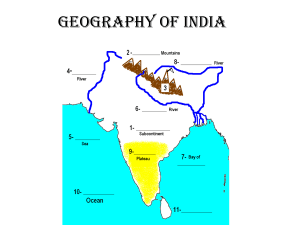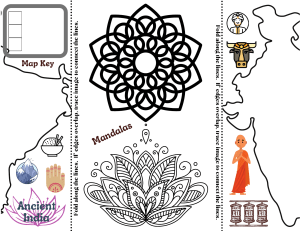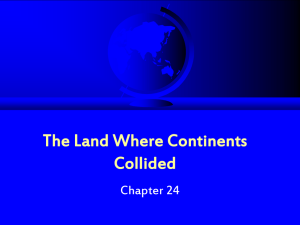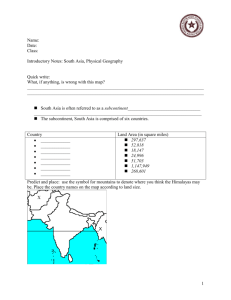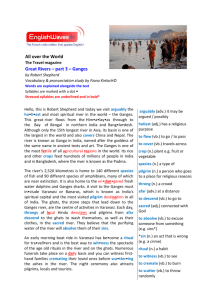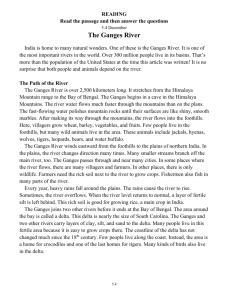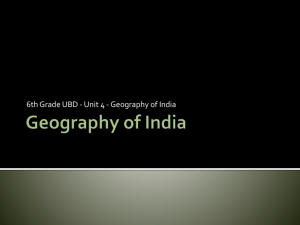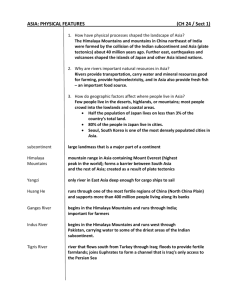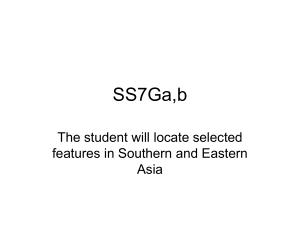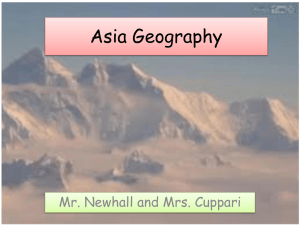File - Ms. Cherry`s Homework Page
advertisement
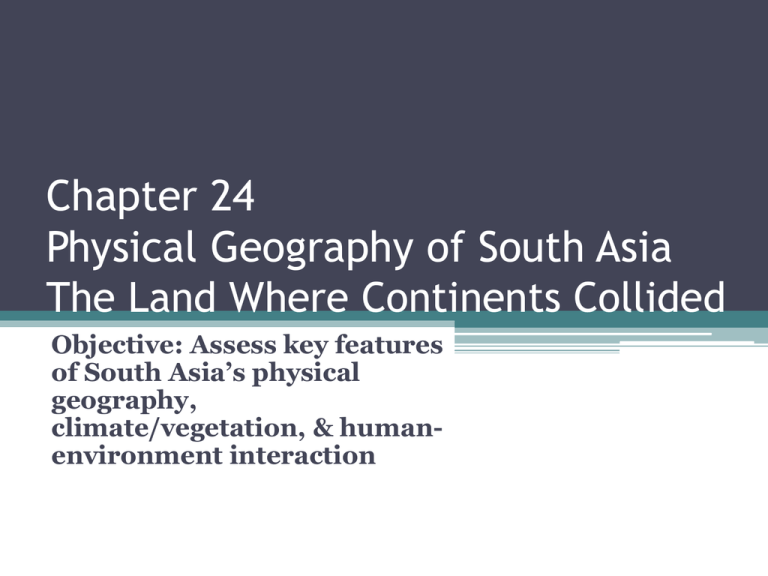
Chapter 24 Physical Geography of South Asia The Land Where Continents Collided Objective: Assess key features of South Asia’s physical geography, climate/vegetation, & humanenvironment interaction Chapter 24 Section 1 Landforms & Resources Vocabulary: Himalaya Mountains, Subcontinent, Alluvial Plain, Archipelago, & Atoll Objective: Describe the subcontinent of South Asia Mountains & Plateaus • South Asia is a subcontinent – a large landmass that is smaller than a continent • Mountains & water surround the region cutting it off from the rest of Asia • During continental drift, the subcontinent collided with Asia pushing the land upward creating mountain ranges • The Himalaya Mountains are 24000 ft high & stretch 1500 miles • Mt. Everest is the world’s tallest peak • In the northeast are the Karakoram Mountains with the 2nd largest peak K2 Rivers, Deltas, & Plains • The Indus & Ganges are two of the greatest river systems in South Asia • These rivers play a key role in supporting life in South Asia • When the rivers overflow their banks, they deposit rich soil on alluvial plains (rich farmlands) • The Indo-Gangetic Plain is also the most heavily populated part of South Asia Offshore Islands • Sri Lanka & the Maldives are located in the Indian Ocean • Sri Lanka is a large tropical island with great natural beauty • Maldives comprise an archipelago (group of 1200 islands) • They are consider atoll islands (ring-like coral island or string of small islands surrounding a lagoon) Natural Resources • The subcontinent coasts a wide variety of natural resources that support human life • South Asia relies heavily on soil & water resources to provide food through farming & fishing • Water also provides a means of transportation & power • Forest products are another important resource in South Asia • South Asia is abundant in coal & iron ore & other metals Chapter 24 Section 2 Climate & Vegetation Vocabulary: Monsoon & Cyclone Objective: Examine climate zones & weather patterns Climate – Wet & Dry, Hot & Cold • South Asia has 6 climate zones & must adapt to widely varying conditions • South Asia as a whole is affected by monsoons (seasonal winds) • October – February: dry winds blow across South Asia from the northeast • June – September: moist air blows in from the southwest across South Asia • The most extreme weather pattern of South Asia is the cyclone (violent storms with fierce winds & heavy rains) Vegetation: Desert to Rain Forest • Vegetation ranges from desert shrub & temperate grasslands to dense forests in the wettest areas • The most forested parts of South Asia lie within the tropical wet zone • Deforestation is a problem everywhere • Cutting down forests has caused soil erosion, flooding, climate changes, & lost of wildlife habitats Chapter 24 Section 3 Human-Environment Interaction Vocabulary: Hinduism, Ganges River, Storm Surge, & Estuary Objective: Learn about the relationship between Hindus & the Ganges Living Along the Ganges • Hinduism is the religion of most Indians • To Hindus, the Ganges River is not only an important water resource, but it is also a sacred river • The Ganges is a sacred river that brings life to its people • Along the river 350 million people live • However, the Ganges has become one of the most polluted rivers in the world • Millions of gallons of raw sewage & industrial waster flow into the river everyday Controlling the Feni River • The Feni river flows through a low-lying coastal plain that borders the Bay of Bengal before it reaches the sea • Cyclones bring high waters called storm surges • Bangladesh has the largest estuary (dam) in South Asia to deal with the Feni river
